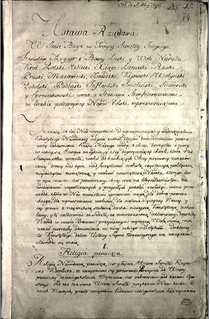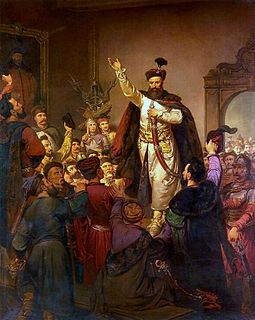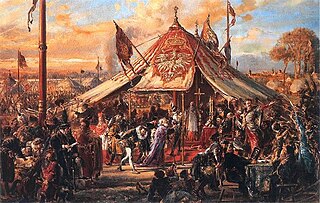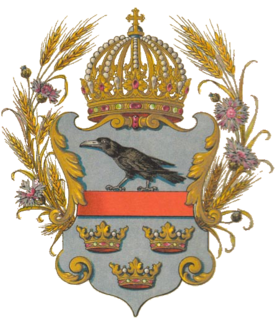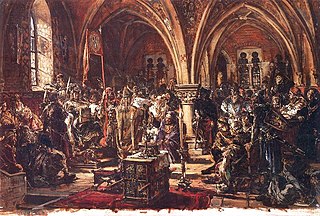Guardians of the Laws or Guard of Laws (Polish : Straż Praw) was a short-lived supreme executive governing body of the Polish–Lithuanian Commonwealth established by the Constitution of May 3, 1791. It was abolished, together with other reforms of the Constitution, after the Polish defeat in the summer of Polish–Russian War of 1792.
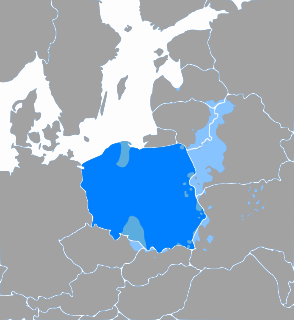
Polish is a West Slavic language of the Lechitic group. It is spoken primarily in Poland and serves as the native language of the Poles. In addition to being an official language of Poland, it is also used by Polish minorities in other countries. There are over 50 million Polish language speakers around the world and it is one of the official languages of the European Union.

The Polish–Lithuanian Commonwealth – formally, the Crown of the Kingdom of Poland and the Grand Duchy of Lithuania and, after 1791, the Commonwealth of Poland – was a dual state, a bi-confederation of Poland and Lithuania ruled by a common monarch, who was both King of Poland and Grand Duke of Lithuania. It was one of the largest and most populous countries of 16th– to 17th-century Europe. At its largest territorial extent, in the early 17th century, the Commonwealth covered almost 400,000 square miles (1,000,000 km2) and sustained a multi-ethnic population of 11 million.

The Polish–Russian War of 1792 was fought between the Polish–Lithuanian Commonwealth on one side, and the Targowica Confederation and the Russian Empire under Catherine the Great on the other.
Executive power in the reformed Commonwealth government, according to Article V and Article VIIrested in the hands of "the king in his council", the council being a cabinet of ministers known as the Guardians of the Laws. [1] [2]
The ministries could not create or interpret the laws, and all acts of the foreign ministry were provisional, subject to parliament (Sejm)'s approval. [1] This council was presided over by the king and comprised the Roman Catholic Primate of Poland (who was also president of the Education Commission) and five ministers appointed by the king: a minister of police, minister of the seal (i.e. of internal affairs – the seal was a traditional attribute of the earlier Chancellor), minister of the seal of foreign affairs, minister belli (of war), and minister of treasury. [3] In addition to the ministers, council members included – without a vote – the Crown Prince, the Marshal of the Sejm, and two secretaries. [1] This royal council was a descendant of similar councils that had functioned over the previous two centuries since King Henry's Articles (1573) and the recent Permanent Council. Acts of the king required the countersignature of the respective minister. [4] The ministers, however, were responsible to Sejm, which could dismiss them by a two-third vote of no confidence by the members of both houses. [3] [5] [6] The stipulation that the king, "doing nothing of himself, ... shall be answerable for nothing to the nation", parallels the British constitutional principle that "The King can do no wrong." (In both countries, the respective minister was responsible for the king's acts.) [4] Ministers could be also held accountable by the Sejm court, and Sejm could demand an impeachement trial of a minister with a simple majority vote. [4] [5]
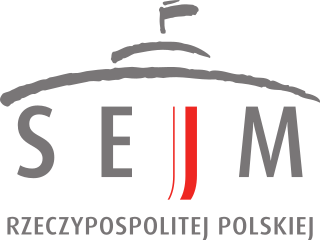
The Sejm of the Republic of Poland is the larger, more powerful lower house of the Polish parliament. It consists of 460 deputies elected by universal ballot and is presided over by a speaker called the "Marshal of the Sejm of the Republic of Poland". In the Kingdom of Poland, "Sejm" referred to the entire three-chamber parliament of Poland, comprising the Chamber of Envoys, the Senate and the King. It was thus a three-estate parliament. Since the Second Polish Republic (1918–1939), "Sejm" has referred only to the larger house of the parliament; the upper house is called the Senat Rzeczypospolitej Polskiej.

Chancellor of Poland was one of the highest officials in the historic Poland. This office functioned from the early Polish kingdom of the 12th century until the end of the Polish–Lithuanian Commonwealth in 1795. A respective office also existed in the Grand Duchy of Lithuania since the 16th century.
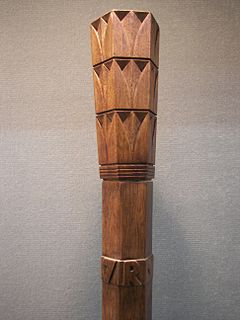
Marshal of the Sejm also known as Sejm Marshal, Chairman of the Sejm or Speaker of the Sejm is the speaker (chair) of the Sejm, the lower house of the Polish parliament. The office traces its origins to the 15th century. In modern Poland, the full title is Marshal of the Sejm of the Republic of Poland.
The decisions of the royal council were carried out by commissions, including the previously created Commission of National Education, and the new Commissions for Police, the Military and the Treasury, whose members were elected by Sejm. [4]

The Commission of National Education was the central educational authority in the Polish–Lithuanian Commonwealth, created by the Sejm and the King Stanisław II August on October 14, 1773. Because of its vast authority and autonomy, it is considered the first Ministry of Education in European history and an important achievement of the Polish Enlightenment.

